Winter 2022/2023 began strongly, bringing record cold and snow into parts of the United States and Canada. But what will the coming months offer regarding snowfall? First, we will look at the latest global drivers and then the snowfall predictions and trends from mid-Winter into the early Spring.
We have to take a quick look at the leading background drivers of global weather this winter season. What does the latest analysis data show, and what influence did it play on temperature and snowfall patterns in the past?
But our primary focus is on global long-range weather forecasting systems. We will show you their snowfall predictions for the rest of Winter and the early part of Spring.

GLOBAL WEATHER CONNECTIONS
A significant global weather factor this Winter is ENSO. This region of the equatorial Pacific Ocean changes between warm and cold phases. Typically there is a phase change around every 1-3 years.
ENSO phases significantly influence tropical rainfall, pressure patterns, and the feedback between the ocean and the atmosphere. The image below shows the circulation pattern of a cold phase (currently active) and its ocean-atmosphere connection.

This way, the ENSO impacts tropical rainfall and pressure patterns, changing the atmosphere-ocean feedback system. The ENSO influence is spread globally through this feedback system, creating a strong change in Winter temperature and snowfall patterns.
Below is the latest surface analysis of the tropical Pacific Ocean. You can see the ENSO region in the cold phase (La Nina). But the cold anomalies are weakening, losing the organized shape, and starting to break down slowly.

La Nina usually forms during strong trade winds, which can tell us much about the state of global circulation. This way, we can use these anomalies as an “indicator” to better understand the current state of the global climate system and its seasonal development.
Below, you can see the progress of the ENSO temperature in the last two years. It shows that we are currently in a moderate negative phase lasting for a prolonged period. This is also the final cold phase for at least two years.

As you will see, we will likely shift into a warm phase for the 2023/2024 Winter Season.
LA NINA WINTER FORECAST
Below we have an Official NOAA CPC probability forecast graphic, which shows the long-range forecast of the central ENSO region. The cold La Nina conditions are forecast to decay quickly over Winter. However, going deeper into 2023, you can see an increased probability of a warm phase (El Nino) developing.

To better understand the ocean changes across the ENSO regions, we produced a video showing the La Nina anomalies from Summer into Fall.
The video below shows the developing cold ocean anomalies in the equatorial Pacific, boosted by the strong easterly trade winds.
So what exactly does this mean for the winter weather patterns and snowfall potential? Despite weakening, La Nina is still active and creates its global influence.
We will take a closer look at the weather effects that La Nina usually shows over North America, which is under a more direct influence.
Europe is not known to have any specific/direct influences, as it is too far from the source regions. But that does not mean it has no impact.
La Nina does change the weather globally, but apart from the direct influence over North America, places like Europe have many other factors in circulation before any La Nina influence can spread this far.
NORTH AMERICA WINTER PATTERNS
Typically, the first influence of these ocean anomalies can be seen in the jet stream changes. The jet stream is a large and powerful stream of air (wind) at around 8-11km (5-7mi) altitude.
Historically, a strong blocking high-pressure system in the North Pacific is the most typical effect of a cold ENSO phase. That tends to redirect the polar jet stream down over the northern United States, with the cold air following the same path.
The image below shows the average pressure pattern during the La Nina winters over the past 40 years. You can see a strong high-pressure system in the North Pacific and a low-pressure area over Canada and the northern United States. Images by NOAA Physical Science Laboratory.

The circulation of the strong high-pressure system promotes the development of a low-pressure region over Canada. That relocates the jet stream downwards between the two strong pressure systems, marked above by the blue lines.
Looking at the temperature analysis for the same winters, we can see a cold anomaly following the jet stream from western Canada into the northern United States. This is the same path that the strong cold arctic air outbreak has across the United States this week.
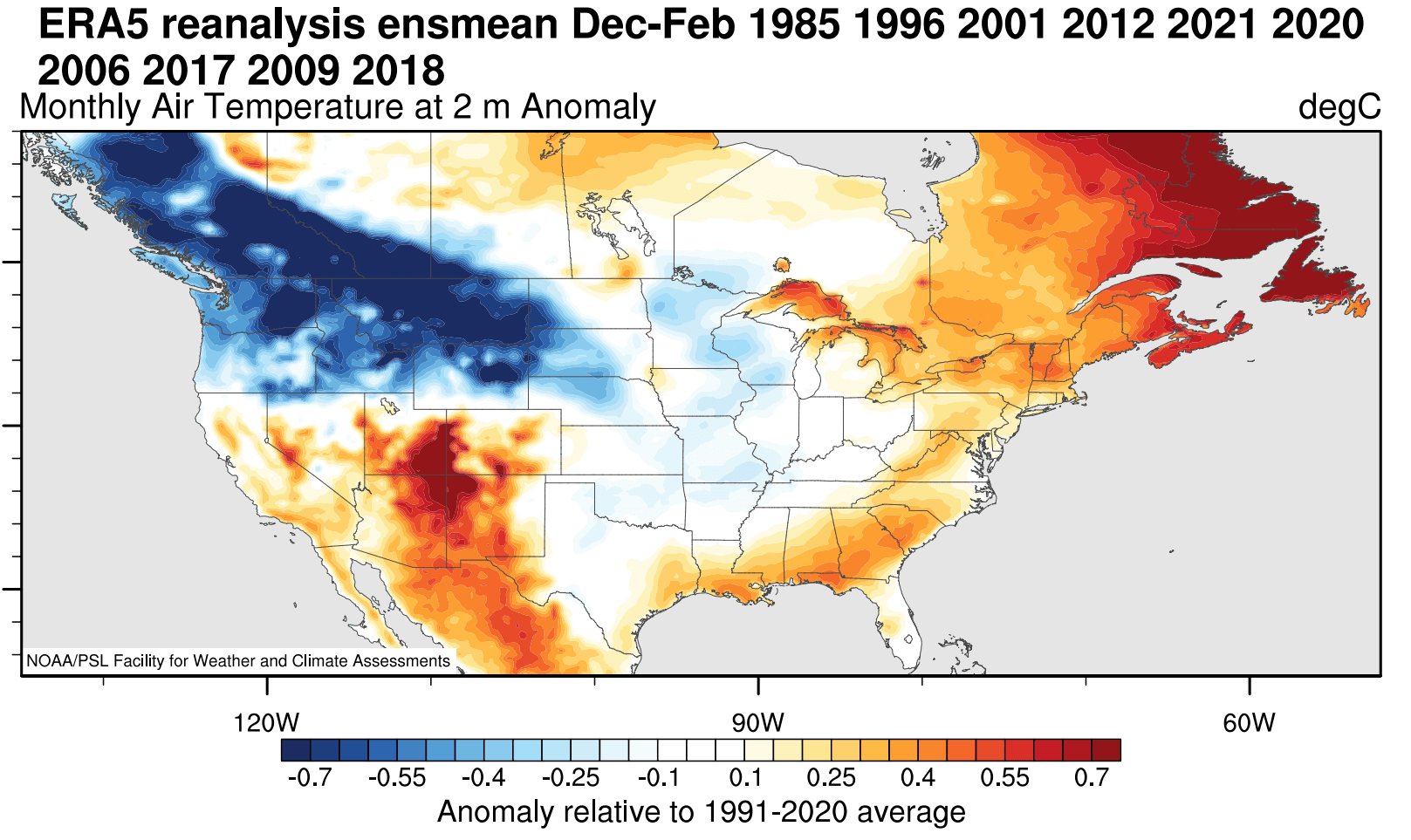
Warmer than average weather and mild winter conditions typically develop over the southwestern United States, eastern United States, and eastern Canada. The most dynamic winter weather tends to occur between the warm and cold anomalies in the Midwest and the central United States.
Precipitation-wise, La Nina winters are usually drier over the southern United States. Drier conditions also develop in the southeastern United States. La Nina produces a weaker subtropical jet stream and less moisture over the southern United States. As a result, more precipitation is typical over the northwestern United States, the Great Lakes, and parts of the northeast.
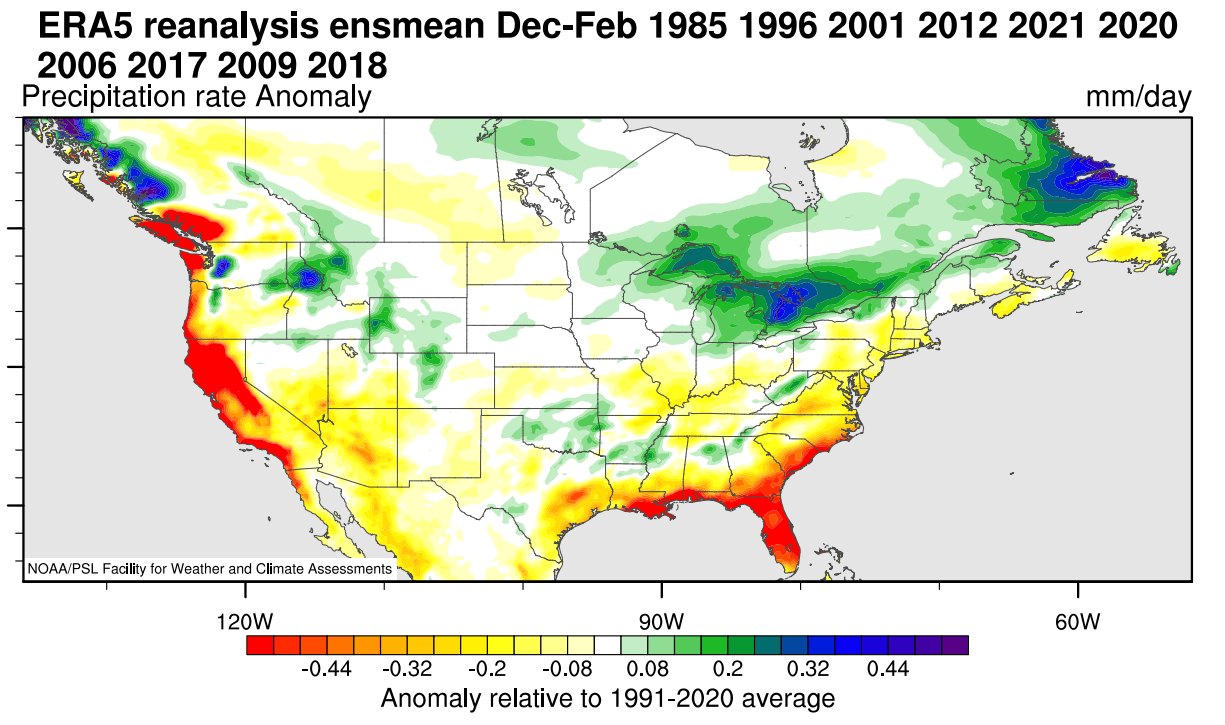
You can see the La Nina jet stream redirection in the image below. It shows the average jet stream position and the resulting weather patterns over the United States and Canada in cold-ENSO winters.

The displaced jet stream brings colder temperatures and winter storms from the polar regions down into the northern and northwestern United States. Warmer and drier winter weather prevails over the southern states.
But what does that mean for snowfall potential? Of course, any change in the jet stream also changes the snowfall patterns over North America. The pressure systems take a different path along with the cold air required for snowfall.
The colder air is more easily accessible to the northern United States, which increases the snowfall potential if enough moisture is available. The graphic below by NOAA Climate shows the average snowfall pattern for weak/moderate La Nina years.

Besides the northwestern United States and the Midwest, we can see more snowfall potential over the northeastern United States and eastern Canada.
But now, we will look at snowfall predictions for mid-Winter and early Spring. Data is from the leading global long-range forecasting systems.
The format of this forecast is simple. We will look at the ECMWF and UKMO seasonal forecasting systems. We used the latest data available at present, released in early-mid December.
You will see the average snowfall forecast for the mid-Winter season, covering the January-February period. We will also include the March and April data, as the early Spring can still provide strong cold air outbreaks and snowfall events.
ECMWF WINTER/SPRING SNOWFALL LATEST FORECAST
As always, we start with the ECMWF. It is the most often used and highly regarded seasonal forecasting system. The Copernicus-EU open project provides the ECMWF and UKMO data.
Starting with the seasonal average, we see below-average snowfall over most of Europe, indicative of a dominant high-pressure pattern. Of course, this does not mean there will be no snow, but it indicates less snowfall than usual for this period.

In the January snowfall forecast, there is quite a strong negative anomaly over most of the continent. A more significant deficit can be seen over central Europe, especially over the Alps.
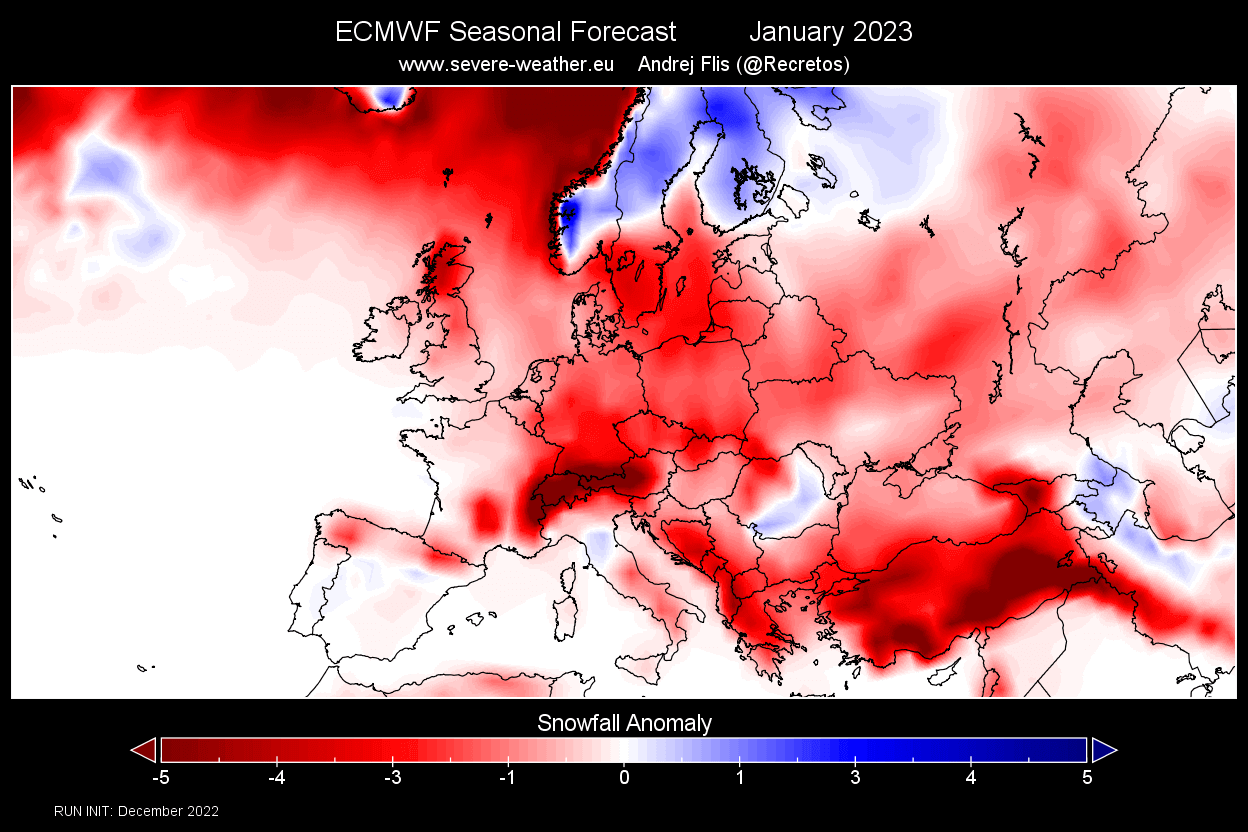
The February snowfall forecast shows no improvement. The snow potential is reduced over most of Europe. However, there are hints of areas with more snowfall in parts of south-central Europe.
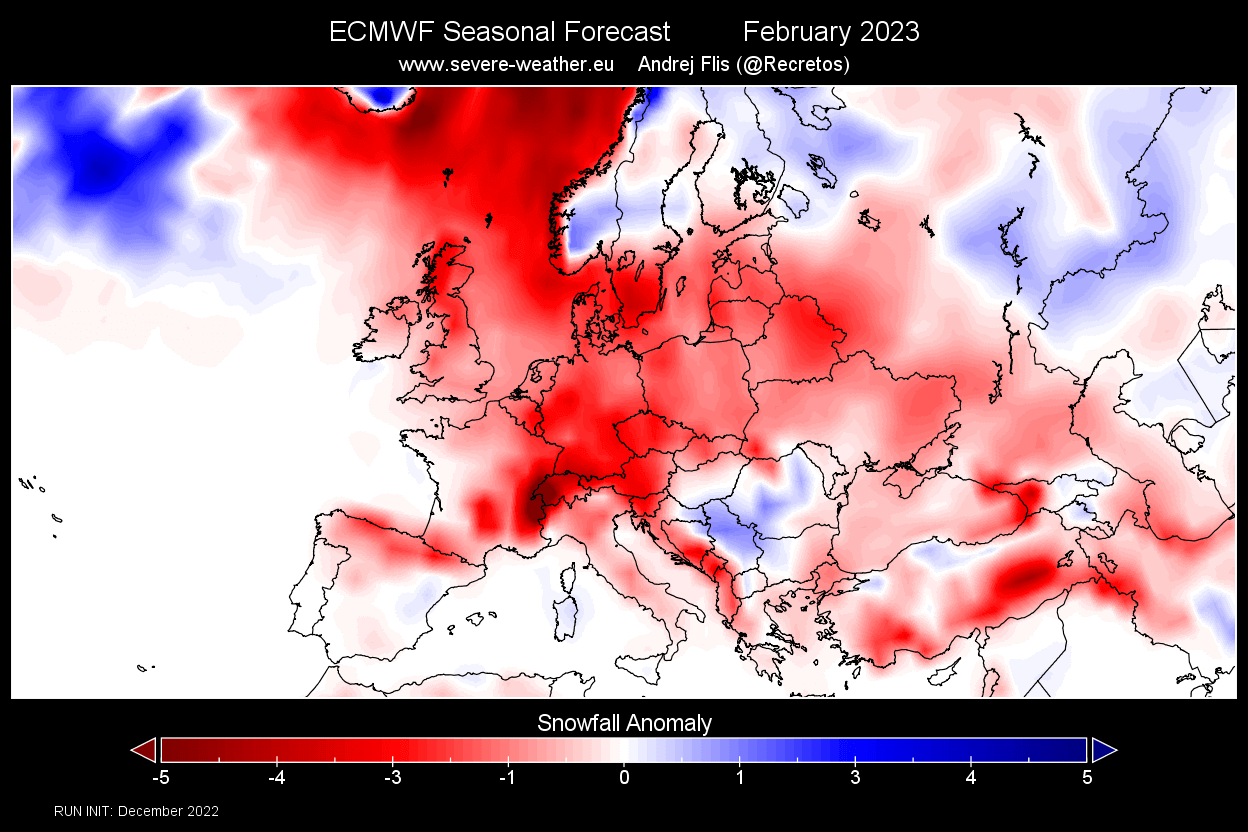
Looking at the March snowfall forecast data, we see some potential in the western Alps. There are also patches with some snowfall indicated over central Europe and also over southern England.

NORTH AMERICA ECMWF SNOWFALL FORECAST
Over North America, most of the southern end has below-average snow accumulation. The exceptions are the northwestern United States, the upper Midwest, and southern Canada. The rest of the United States shows less snowfall than expected in the January-March weather season.

The January snowfall forecast shows a pattern of more snowfall from western Canada into the northwestern United States. We see an increased snow potential over the Midwest and the Great Lakes area. The southern United States and parts of the east show less snowfall than usual.
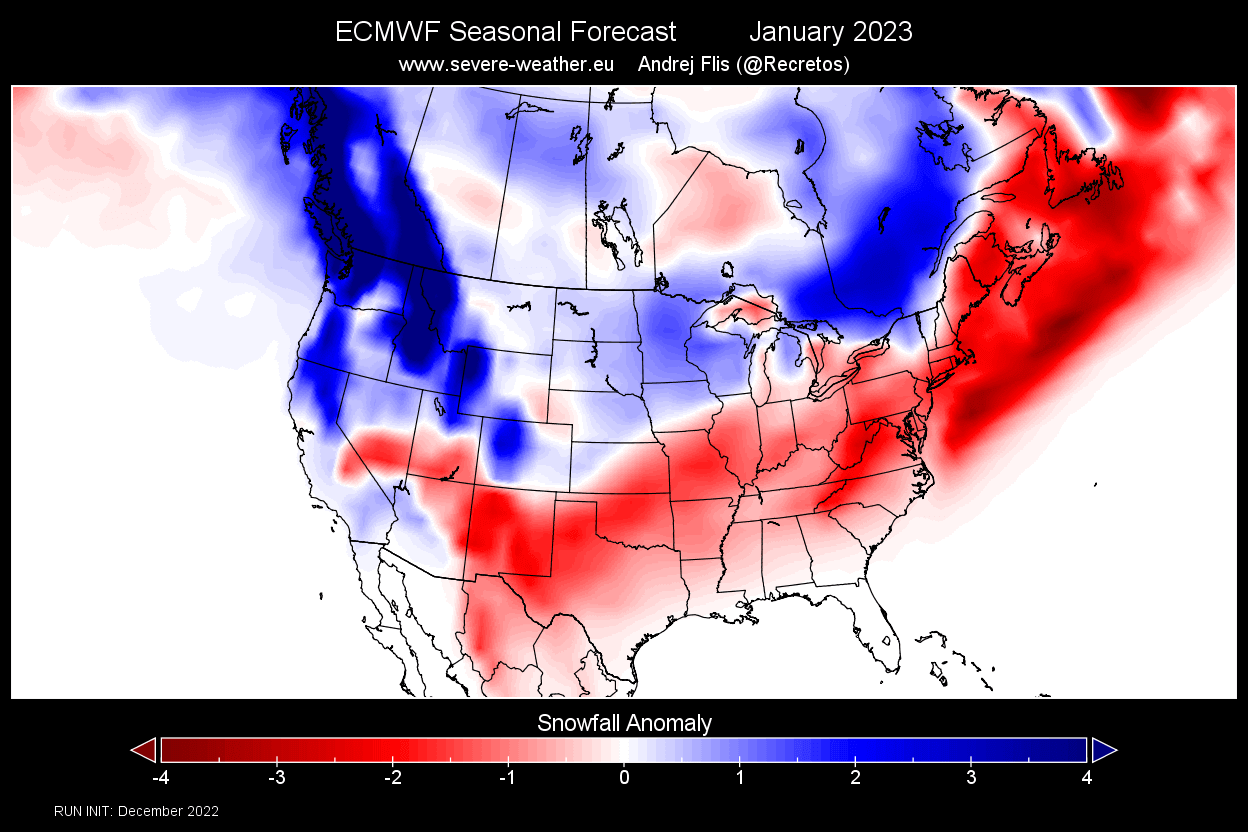
The February snowfall forecast shows continued snowfall potential over the northwestern United States and expanding over southern Canada into the northeastern United States. More snowfall is still forecast in the upper Midwest, but less snowfall is forecast across the southern United States.
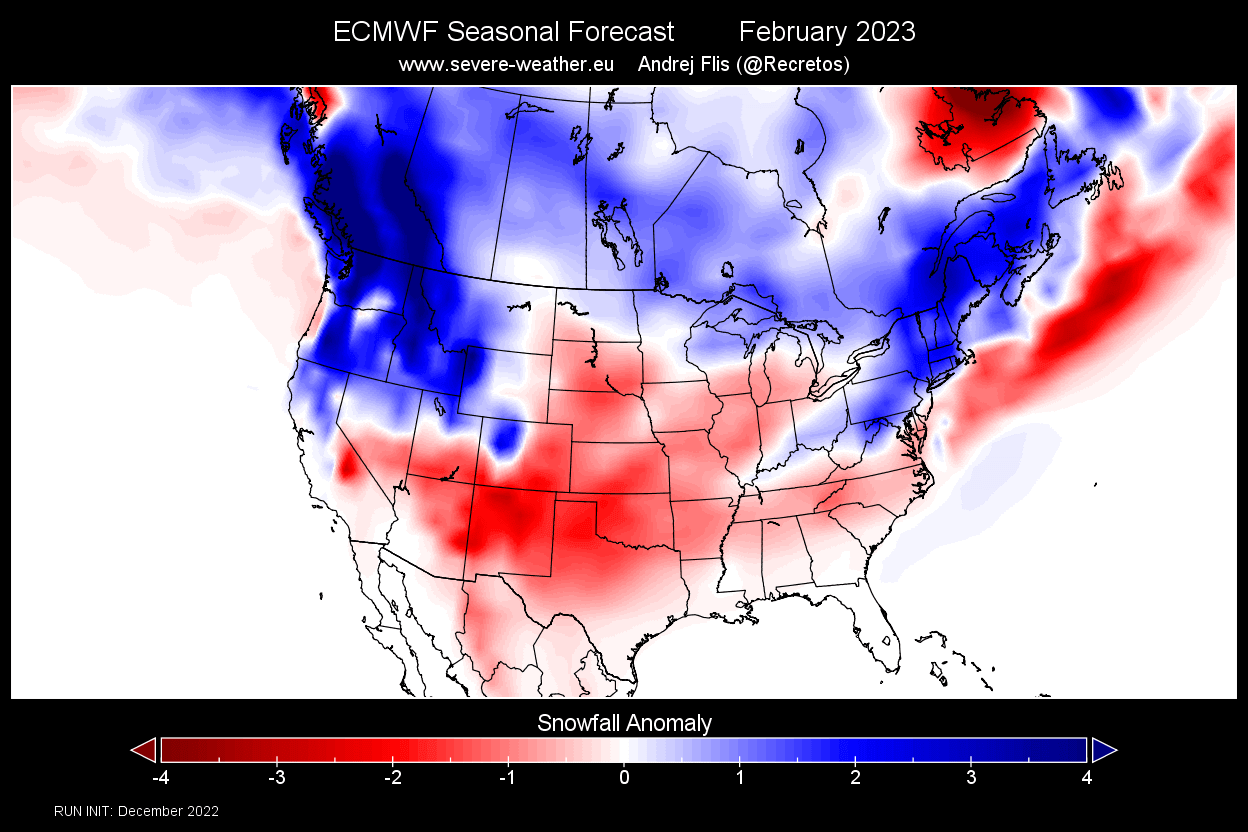
Now going into early Spring, we have the March snow forecast below. Again, you can see more snowfall than average, covering a large area from western Canada into the northwestern United States and parts of the Midwest. The southern half of the United States is expected to see less snowfall in the early Spring.
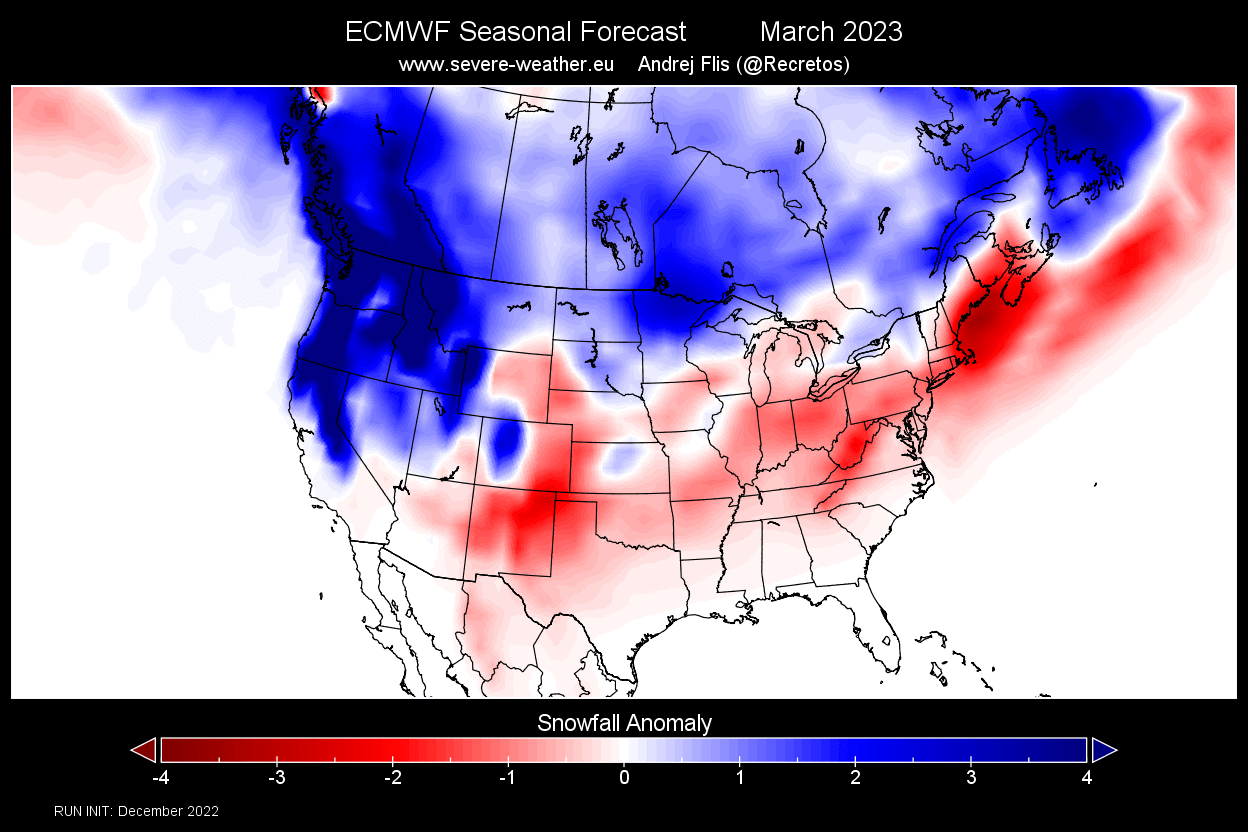
The April snowfall forecast shows a generally weaker snow season across most of the United States. However, we see some interesting hints of more snowfall over the southern plains. This could result from one strong cold anomaly, which can still happen in April.
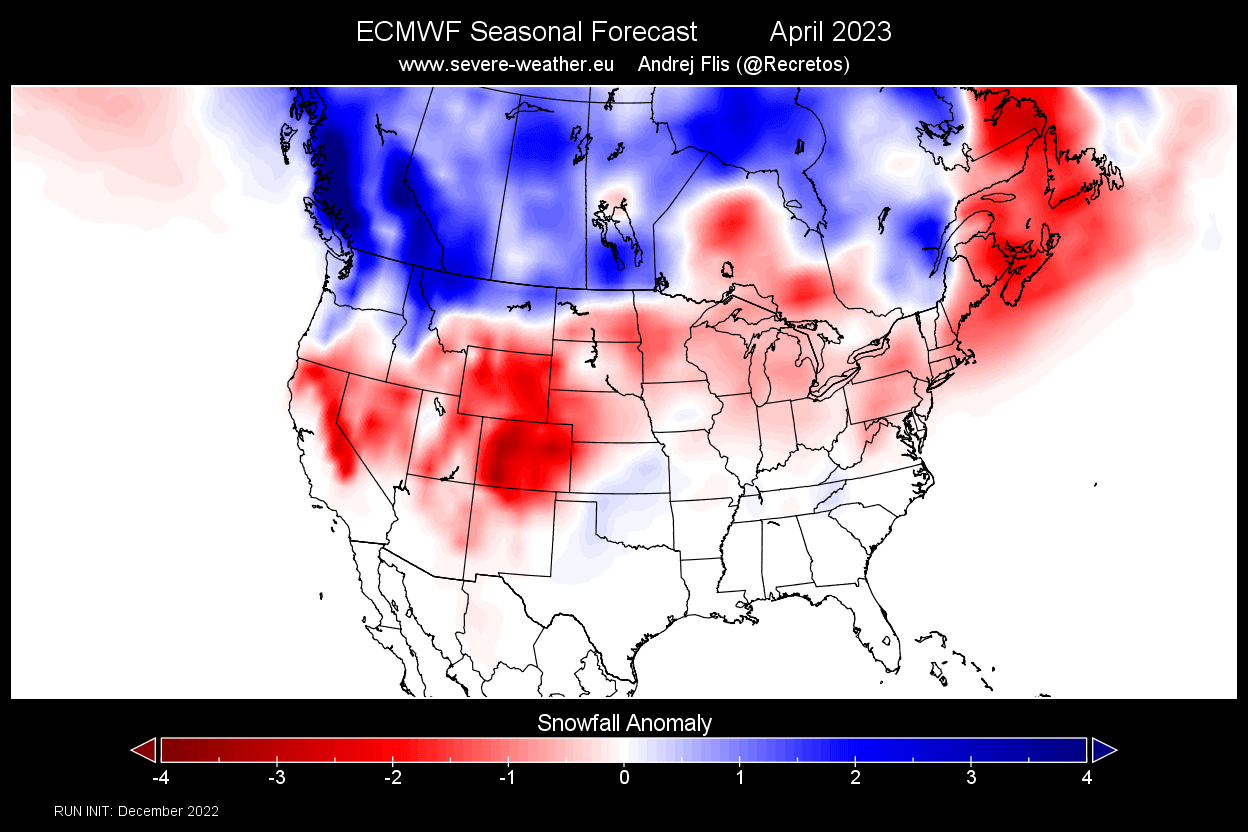
UKMO WINTER/SPRING SNOWFALL FORECAST
Long-range weather forecasting is not easy. There are a lot of factors that can impact seasonal climate. We always focus on trends and probabilities, but still, variation is critical. Therefore, the more forecast data you can look at, the better idea you can get about the expected weather patterns.
As you can never trust a single forecast model, we always have at least one other long-range forecasting system along the ECMWF. Meet UKMO. It was developed by the United Kingdom Met Office, where the initials UKMO come from.
Starting with the seasonal average for Europe, we can see another weak snowfall forecast similar to the ECMWF. Most of the continent is forecast to have less snowfall than average, except for far northern Europe.

The January snowfall forecast shows more potential in far northern Europe. The rest of the continent sees less snowfall than normal for this time of year. This is a very similar forecast to the ECMWF.
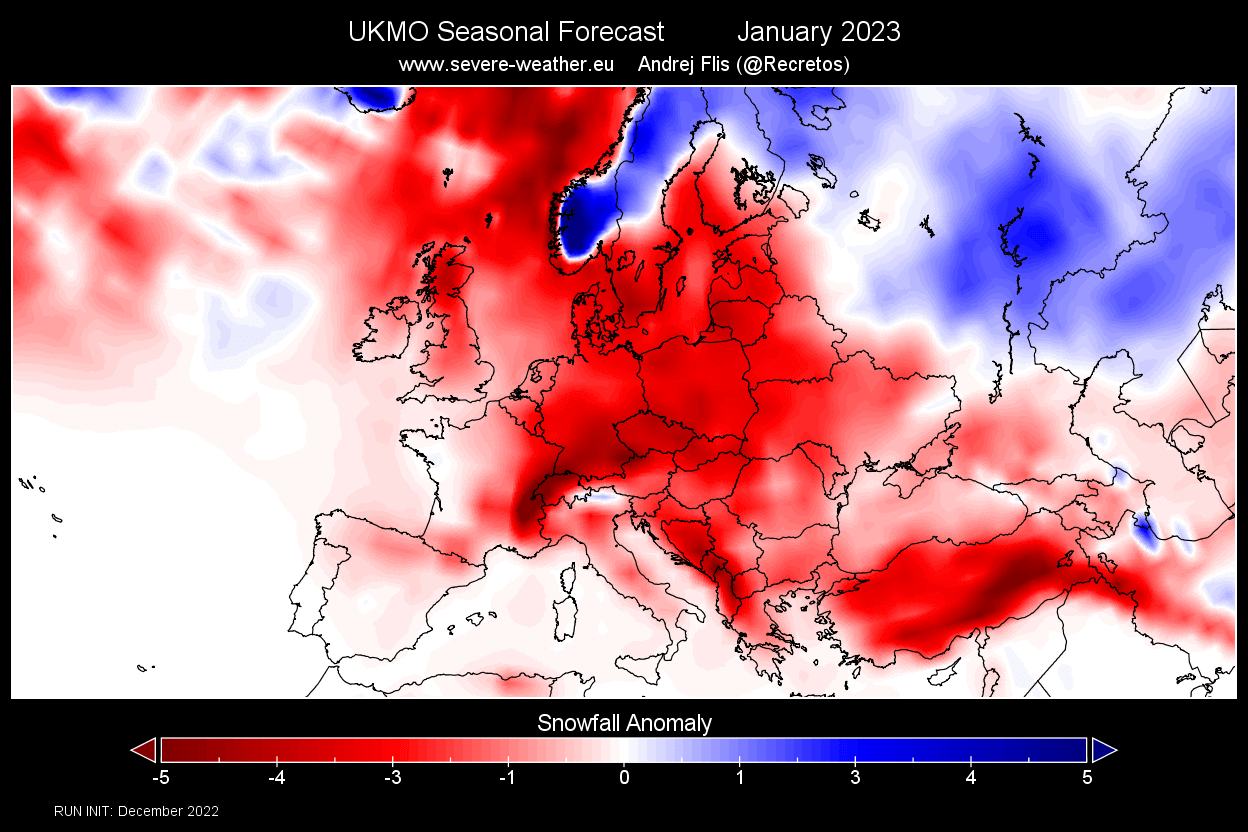
The February snowfall forecast indicates continued potential over the northern parts of Europe. But otherwise, the rest of the continent shows less snowfall this month. Given the distribution of snowfall anomalies, it supports a likely low-pressure zone over northwestern Europe.
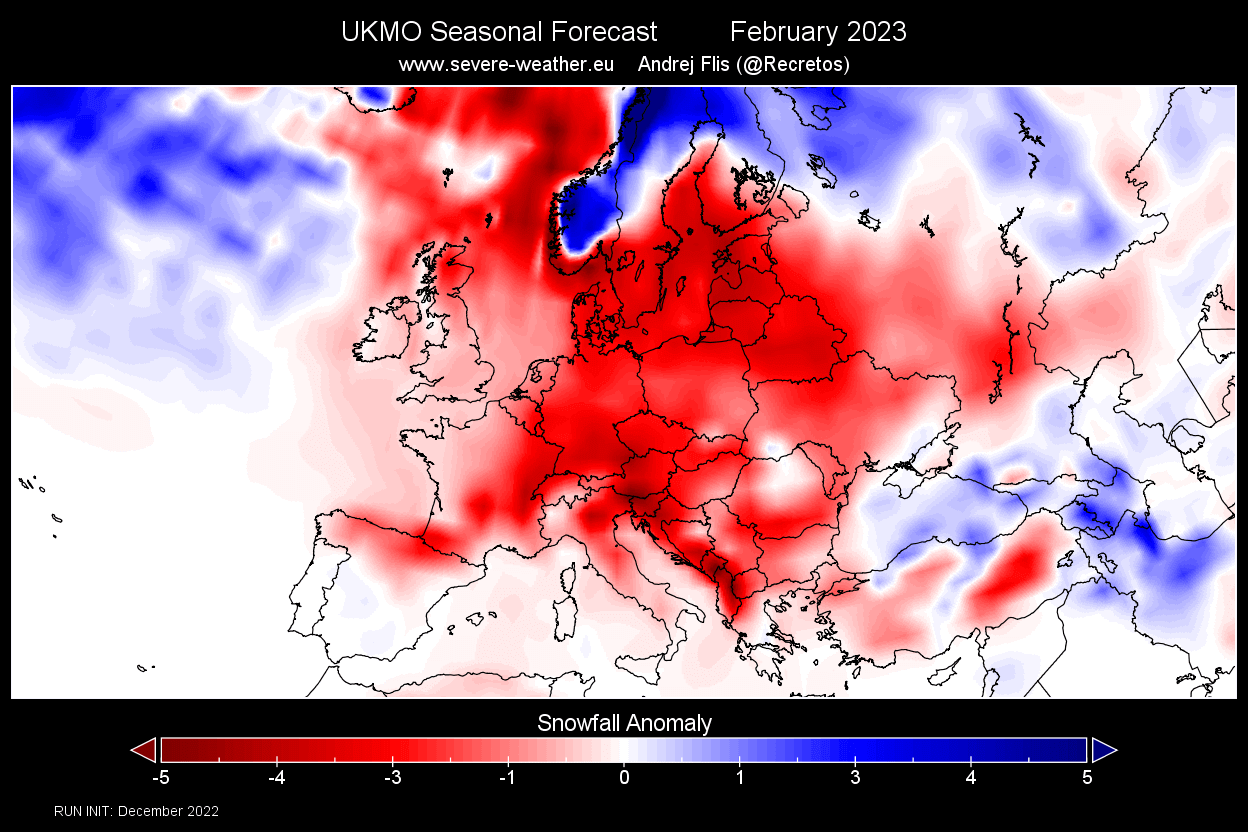
Looking at the March forecast, no late-season surprise is in the works. Early Spring shows no real snowfall potential. But that does not mean we can’t see a cold outbreak or two in this period.
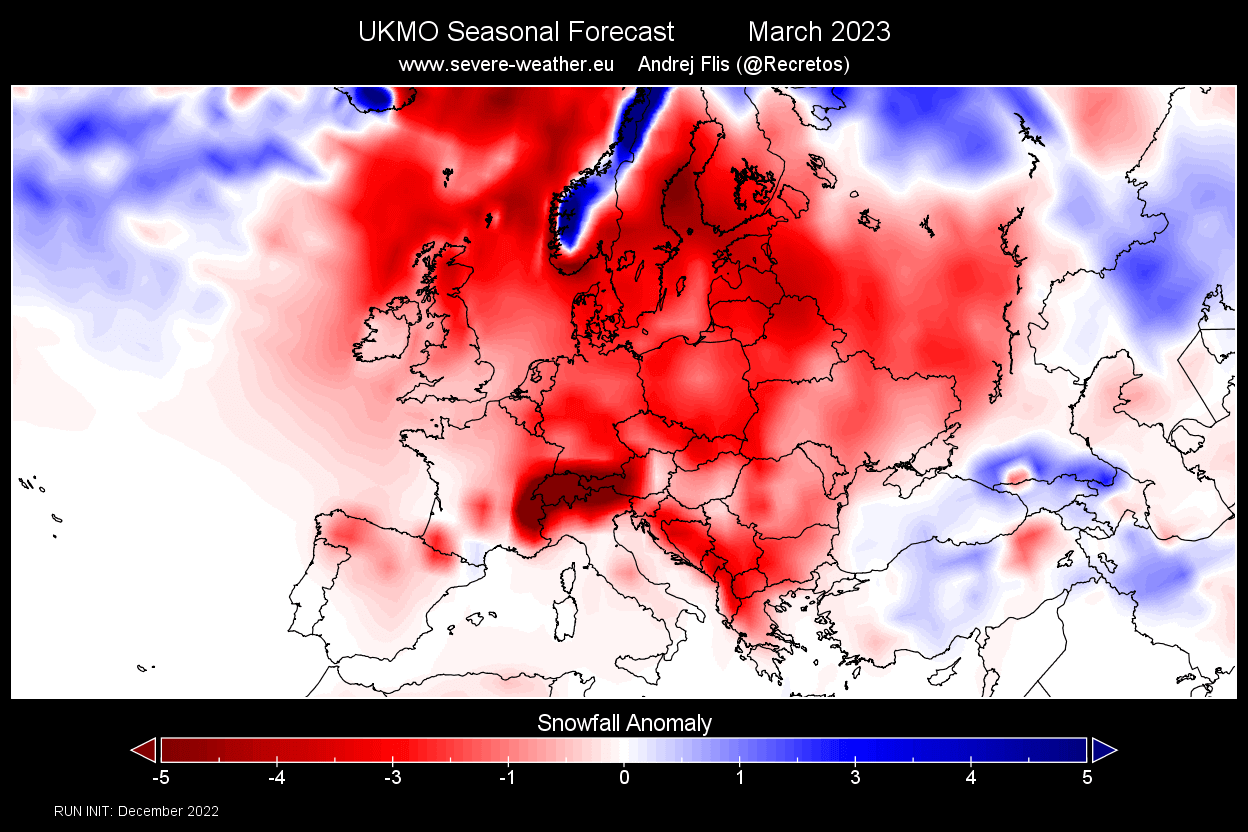
NORTH AMERICA UKMO SNOWFALL PREDICTIONS
The average seasonal forecast for the United States and Canada shows another typical La Nina snowfall pattern. We see more snowfall over the northwestern and northern United States and southern Canada. This is not too far from the ECMWF prediction, but we generally see more snowfall in the northern United States in this forecast.
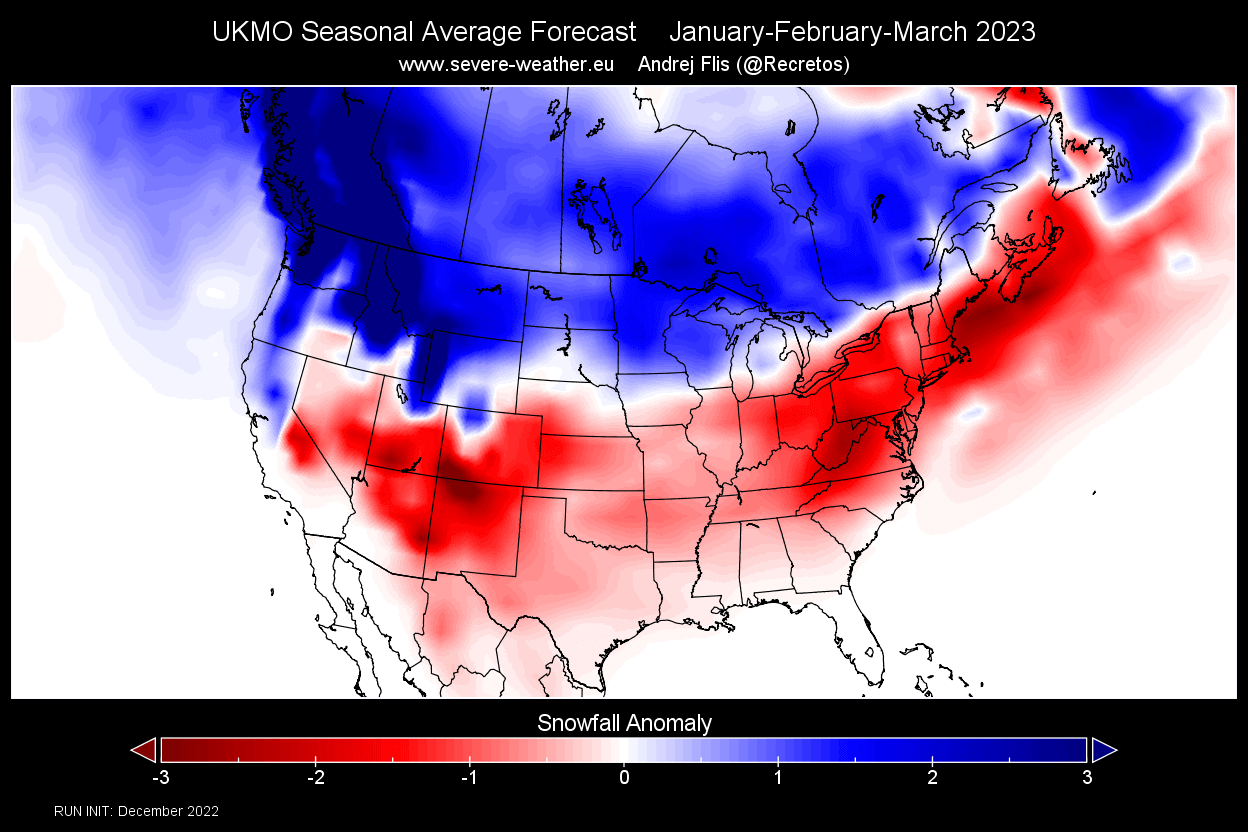
January snowfall forecast shows this pattern, with more snowfall over much of southern Canada and the northern parts of the United States. Most of the southern half of the United States shows less snowfall than normal for January.
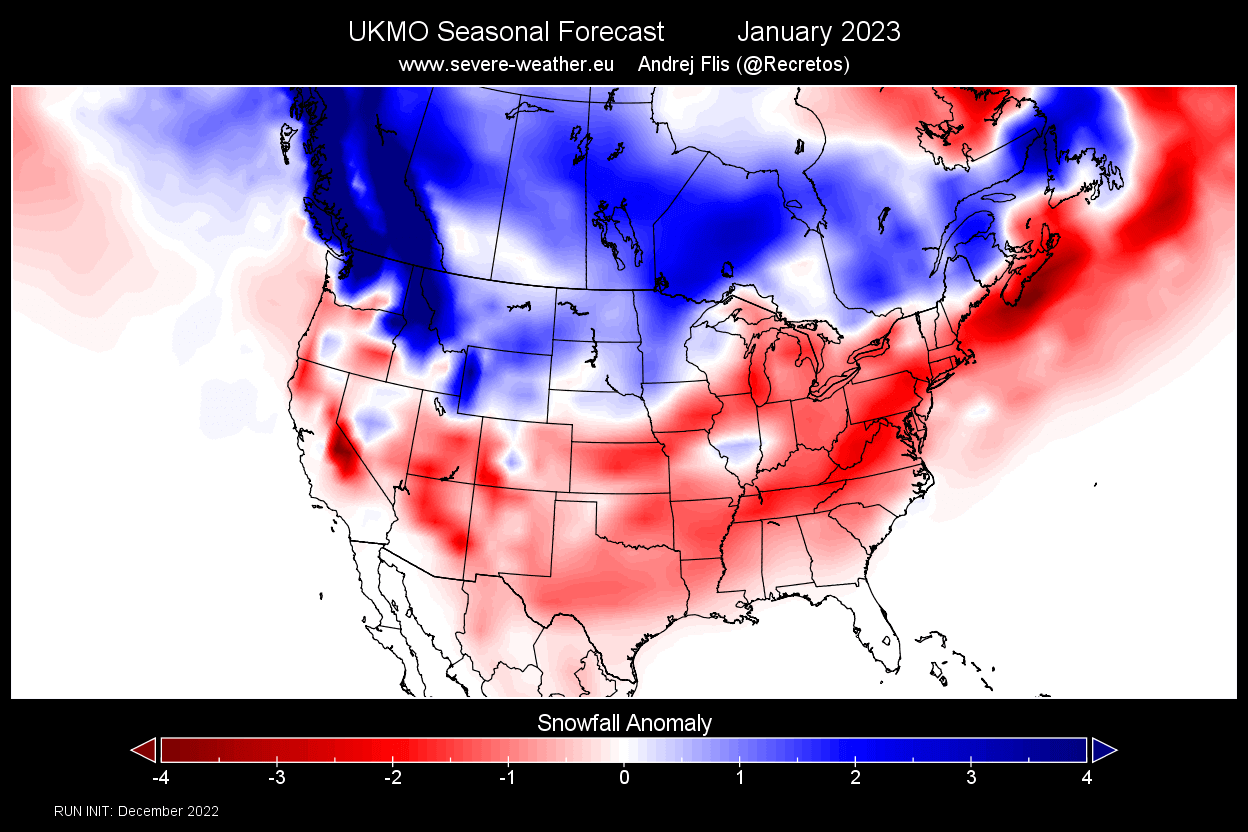
The February snowfall forecast shows snowfall potential increasing over the northern parts of the United States. We can especially see a snowfall increase across the Midwest, reaching down into the southern plains.
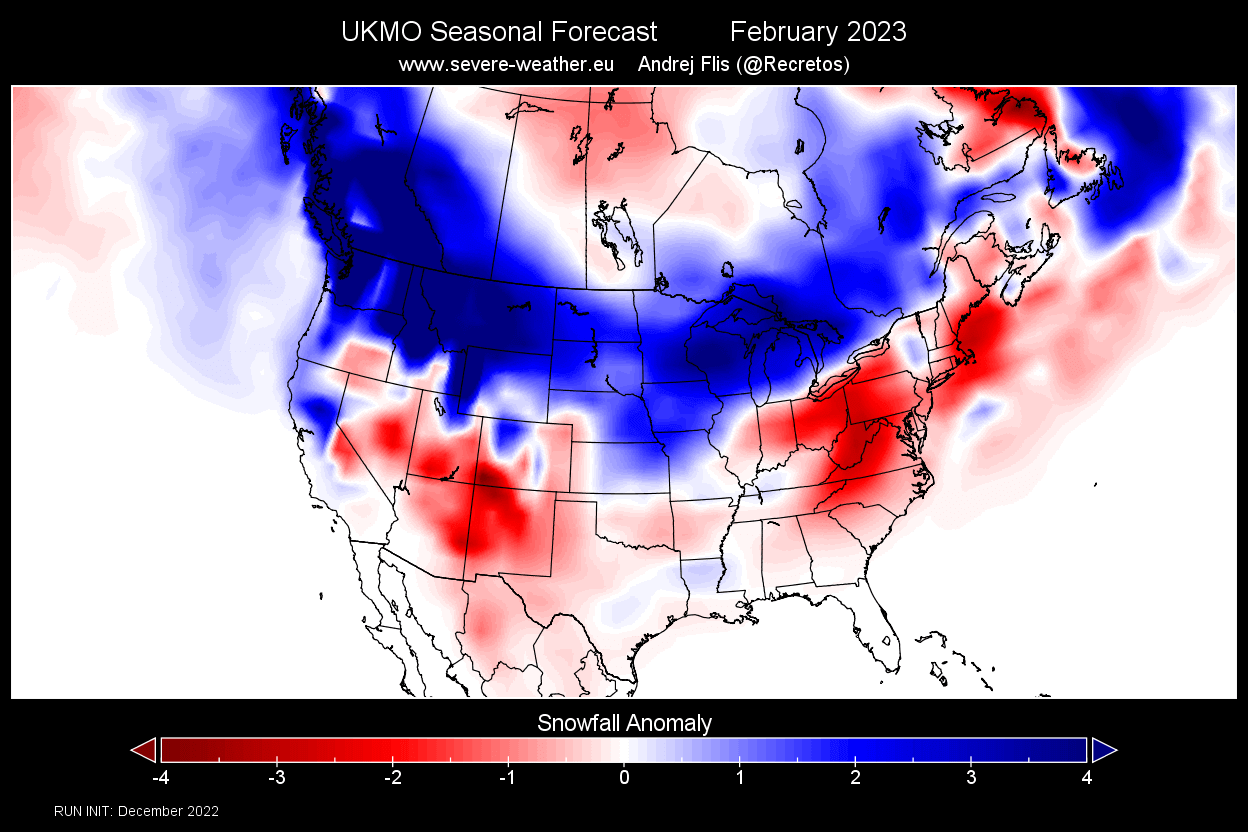
The March snowfall forecast shows a decent snow season continuing over the northwestern United States and the upper Midwest. Most central, southern, and eastern United States show reduced snowfall in the early Spring.

Looking at the April snowfall forecast, we see some snowfall potential in the upper Midwest and the northwestern United States. This is likely associated with continued cold air presence in southern Canada, continuing into early Spring.
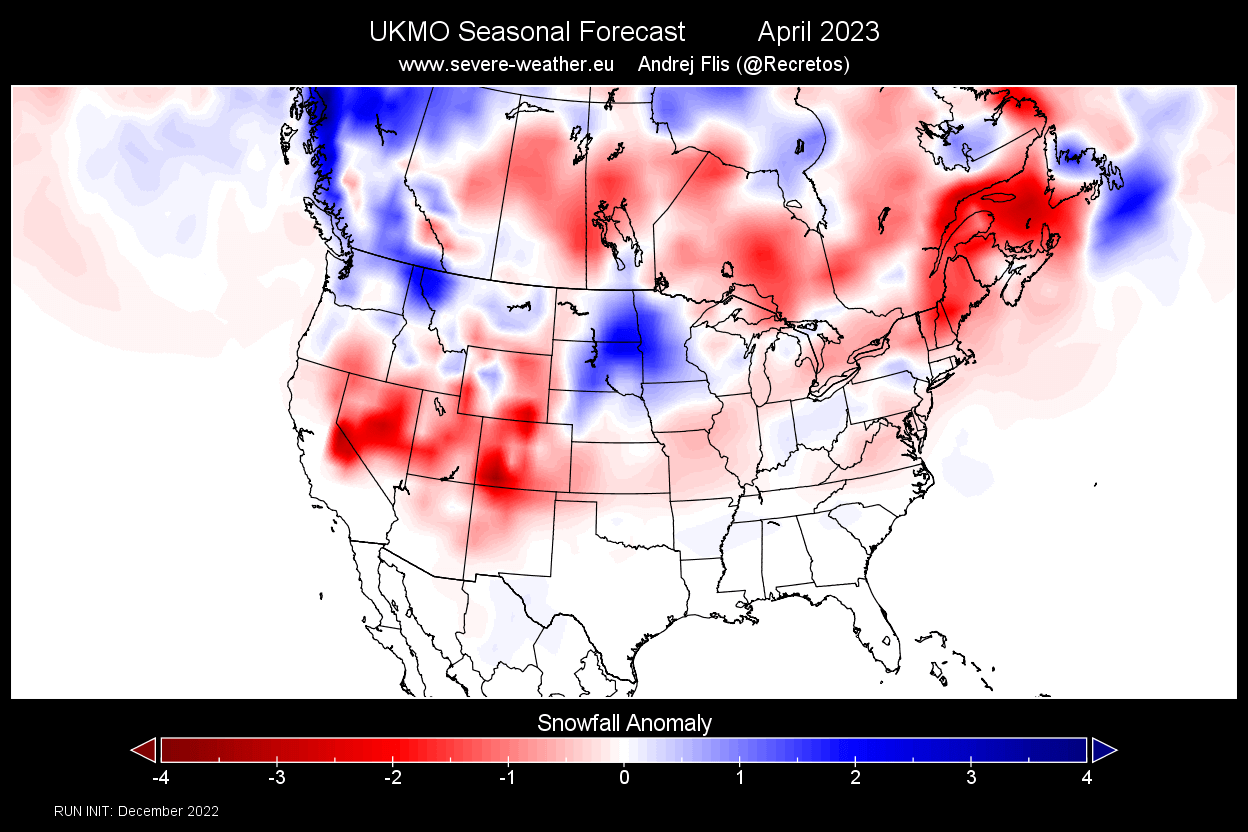
Overall, the UKMO shows a decent snow season across the northern parts of the United States. It also shows some snow scenarios over the central United States.
OFFICIAL NOAA MID-WINTER AND EARLY SPRING FORECAST
We can also track snowfall potential with temperature and precipitation Winter forecasts. The highest snowfall potential is usually in regions with colder temperatures and more precipitation.
This can be seen in the NOAA’s latest official January-March 2023 temperature forecast for the United States. It shows colder temperature probabilities for most of the northern United States. The southern half of the country has a higher probability of warmer than normal weather.
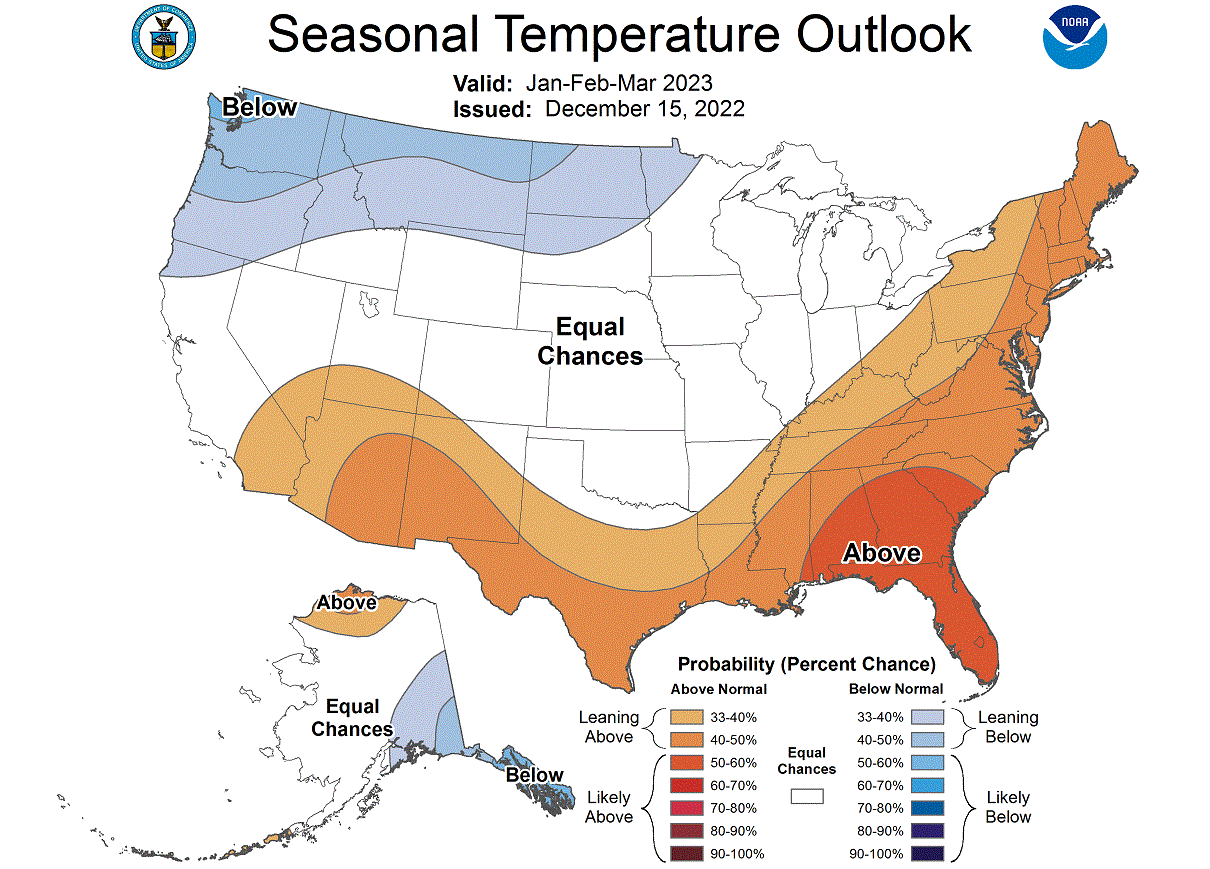
But take note of the trough of “equal” temperatures probability extending down low into the south-central states. That can be interpreted as a potential route of winter cold air outbreaks down from the Midwest to the south. Such a pattern can create snow events in the south-central states.
The official NOAA Temperature outlook points:
- Warmer-than-average temperatures are favored in the Southwestern United States, the Southeastern states, and along the Atlantic coast.
- Below-normal temperatures are favored from the Pacific Northwest eastward to the western Great Lakes.
The official precipitation forecast is similar to the latest model forecasts. We see an equal-to-higher probability for more precipitation (and snowfall) over the northwest, extending into the Great Lakes and the eastern United States. However, the southern United States is forecast to have a drier-than-normal January-March 2023 weather season.

NOAA Official precipitation outlook points:
- Wetter-than-average conditions are most likely in the Pacific Northwest, the northern Rockies, Great Lakes, and Ohio Valley.
- The greatest chances for drier-than-average conditions are forecast in portions of California, the Southwest, the southern Rockies, the southern Plains, the Gulf Coast, and much of the Southeast.
Also, we will keep you updated on other developing weather trends, so bookmark our page. Also, if you have seen this article in the Google App (Discover) feed, click the like button (♥) there to see more of our forecasts and our latest articles on weather and nature in general.
Don’t miss: